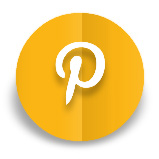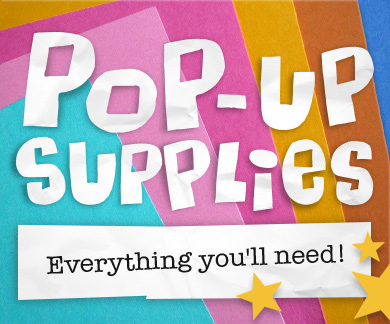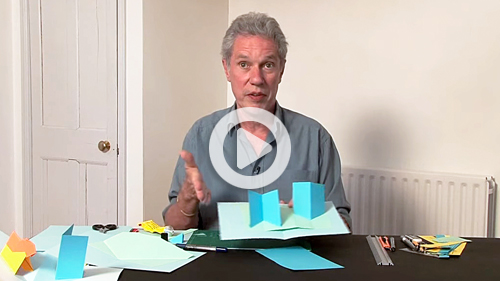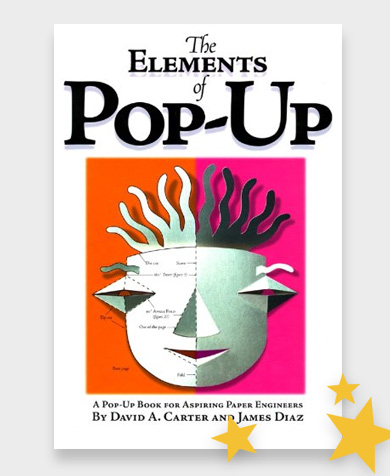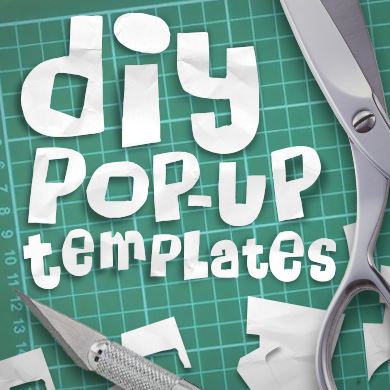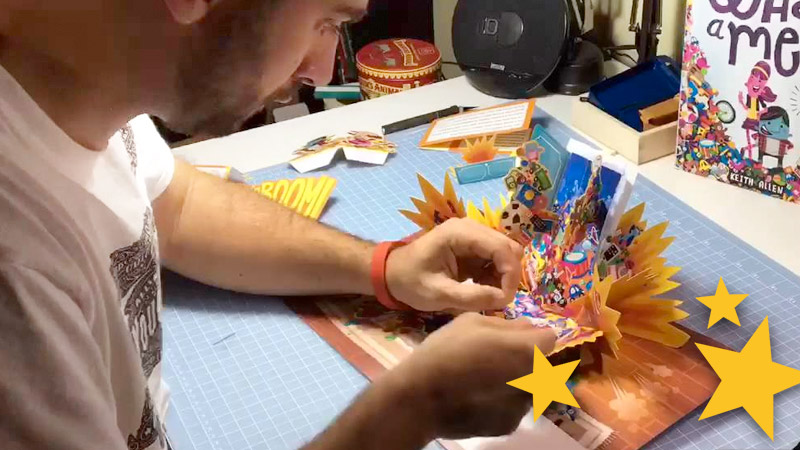
How to make a pop-up book? Sounds like a simple question but that depends on how complicated you want the pop-up book to be. If you take a look at some projects from artists and students on YouTube, you’ll find lots of beautiful self-made pop-up books ranging from basic to very complex. Everything is possible as long as you want to invest time in your project. Making a pop-up book is not something that you will do in a day. It demands dedication, precision, patience and lots of paper.
In this guide, we will try to answer the question How to make a pop-up book? and you’ll get a step-by-step explanation that describes the process that is needed to create and publish a pop-up book. If you don’t have any plans publishing or printing your book, you still can use this guide to find out what is needed to plan a complex project like a pop-up book. We also have a Pop-up Dictionary that can be handy if you want to get familiar with frequently used pop-up related terms. So here we go! How to make a pop-up book in 11 steps!
How to make a pop-up book: step by step
|
1
|
Become a Paper EngineerIt’s easier said than done to become a paper engineer. If it’s your goal to make an advanced pop-up book with complex pop-up techniques, you should be prepared that this is a skill that normally takes years and years to develop. It’s good to keep in mind that an impressive pop-up book isn’t always about how advanced the engineering is. Some of the most beautiful pop-up books use basic pop-up techniques. Start with the basics |
|
2
|
Think of a story or conceptBefore you start designing pop-ups you first have to know what the concept or story will be. This will be the second step in our How to make a pop-up book guide. Working at a big project like a pop-up book takes time and needs structure and a well-designed plan. A story or concept is the base of your plan and must be well thought out. Is it possible to translate your subject into working pop-ups? Will it be a mix of artwork and text or just plain paper pop-ups? Who is your audience? Those are all important questions to ask yourself before you get started. |
|
3
|
Decide what techniques to useWhen you’ve decided what story or concept the pop-up book will be about, you can make a plan for what pop-up techniques you’re going to use. When you already have learned the basics, you now can look at what is possible for you to realize. What techniques can you use for your story? What kind of pop-up is needed to create depth and movement? You can be creative at how you translate basic techniques into a spectacular pop-up by adding artwork or decoration. For example: if you want to create a pop-up boat, you can choose to use a basic V-fold pop and use artwork and cutouts to create the illusion of a boat floating on the water. Or you can choose the hard way and make a more advanced, so-called box pop-up. A box pop-up can be viewed from all angles and used as a base to build a boat with. The V-fold would be the easy way to engineer but it may need some good artwork to let it work. |
|
4
|
Experiment and sketchNow you have a story and some ideas about what pop-up techniques you’re going to use, it’s time to experiment! You first have to decide what shape the pop-up will be and if it works combined with the artwork. Make rough sketches of concept artwork and use those to create some 3D paper structures that almost look like pop-ups. At this point, you don’t have to worry about how good or bad a pop-up works but you do have to keep in mind that it will have to work one day. Once you have build your first design, you can refine the design and at the same time work at the pop-up mechanism. Experiment with dimensions and compositions, test how good it pops in-and-out and rebuild a better version. Repeat this process over and over again until you’ve created a solid working pop-up that looks great. Work on your project page by page but if you get stuck, move on to another page until your story is complete. Adding extra elements |
|
5
|
A working prototype of the book (white dummy)Now you have a collection of pop-up spreads that should be merged into a book. This is the final step in the process of making a prototype: combining all spreads and pages into a strong book. This is called a white dummy, the master of your pop-up book design. Engineers and publishers use the name white dummy because this version is all about the pop-ups functionality. A white dummy also reveals minor errors or wearing without distracting prints. Because of the many versions that are made, there’s no need to work with artwork already because the pop-ups at this stage are all made out of plain paper. The cover needs to be extra strong to keep the pop-ups solid and the pages into place. Some pop-ups may not work that good when the pop-up spreads are attached to each other as book pages. A pop-up can behave differently because of the tension that is needed to make a pop-up work. At this stage, it’s possible that you have to redesign and adjust your pop-ups to make them work as a page in your book. Summary: When you have a single, good working prototype of your book, you can continue making it ready to print. Let’s call this the master copy also known as a white dummy. |
|
6
|
Trace and digitalize the pop-upsNow you have completed your master copy or white dummy, it’s time to take it apart. This may sound crazy because you’ve just finished a perfectly working prototype right? Don’t worry! At this stage, you will be more familiar with all the pop-ups you’ve designed for this book. By making every pop-up over and over again, you have trained yourself how everything is constructed and what the weak points are. The reason why you have to take it apart is because you now have to duplicate your master and the easiest way to do this is digital. You have to trace every piece of all the pop-ups. The lines are called die lines and will be a guide to cut, fold or glue the pop-up. In case your book will be a one-of-a-kind artists copy, you can also trace all pop-ups by hand to speed up the process. Tracing pop-ups is a secure job that can take some time. It’s important to use software like Adobe Illustrator because your tracing lines need to be adjustable afterwards. Adobe Illustrator is the perfect application to work with so-called vector lines. Don’t forget to also mark folding lines, glue points and cut-ins. You can use different colors as an indication so it’s easy to see where you have to cut or fold the paper. Now all the pop-up parts are traced, you have to fit them into a single page that you can print. The size of this page depends on where and how you’re going to print it. |
|
7
|
Creating and adding (digital) artworkIf your design contains artwork, the next step will be adding the final artwork to your die lines. You’ll, therefore, need to digitalize your artwork and import it. Tip: Make sure you’re working in layers! Using different layers for both the die lines and the artwork, it’s easier to print the lines at the back of your artwork afterwards. Artwork can be anything like a scan of a texture, an illustration, a photograph or artwork created in Adobe Illustrator or Photoshop. |
|
8
|
Assembling final demo copiesNow your pop-up book is completely digitalized you can print your designs and assemble final copies of the book to use as presentation or demo models. Before a book goes into production, you’ll need to find a publisher or audience so these final copies are important to use as a demo. It’s very time consuming because you’ll have to cut, fold and glue everything by hand. Be very careful with these copies because you’ll first need to take photo’s or capture it on film with close-ups. After that, you’ll be free to show it to your friends and family and visit publishers and exhibitions to demonstrate your book. |
|
9
|
Find a publisher or crowdfund your bookIf you’re looking for information about how to make a pop-up book, this step might be useless. In case you’ve decided to make just one copy of your book, you can skip this. If you have bigger plans like publishing and printing your book, you should know that it might be very hard to find a publisher for your book. Pop-up books are way more complicated to produce and very expensive (investment) to publish. Most publishers, that are specialized in pop-ups, already work with talented paper engineers from all over the world and you’ll have to come up with a very good concept to make a small chance. The good news is that you can get your book funded with crowdfunding. We already have seen some successful pop-up book project from platforms like Kickstarter and Indiegogo so it’s definitely worth a try! Just keep in mind that starting a crowdfunding campaign also takes a lot of work with it. Finding a manufacturer |
|
10
|
Promote your bookAs an indie publisher, you’ll have to be an author, publisher and PR at the same time. Convincing enough people to back your project is a dedicated job and you’ll need social media platforms to spread the word and keep the conversation going about your book. When you’re working with a publisher, you also need to work for them to promote your pop-up book. There are no rules for promoting a product but the best way to do this is by creating quality content like photos and videos to share and be at every event that you can think of to promote your book. A website about your book Creating your own website can be difficult but there are some basic steps you can start with:
|
|
11
|
ProductionWhat could have been Step 9 in this How to make a pop-up book guide is the production process. But when you’re an indie publisher and your book is a crowdfunding campaign, the production will be the last step for you to take. Your part is to help the manufacturer on its way and through the process of making your book. You’ll also need to do the quality control yourself. Looking for minor errors or mistakes. This QC is necessary at many checkpoints in the production process. |
How to bind a pop-up book cover
A very useful video by Michael McGinnis that demonstrates very clearly how to make a pop-up book cover. A pop-up page needs to be flat when opened so the mechanisms work in an optimal way. A traditional book cover would curl up the center of the spreads, because of the tension that gets created in the centerfold. This can be solved by adding extra spacing between the pages and also by adding extra hinges on the spine of the cover. You will learn how to do it in this video!
Useful links
Now that you’ve read our How to make a pop-up book guide, you maybe would like to know more about pop-ups and get inspiration from talented paper engineers. Go check out our handy links page that contains a lot of links to websites of paper engineers, publishers and pop-up specialists! You can also read our interviews with pop-up book collectors and some of the best paper engineers about their work and recent publications.
Editors note
In this How to make a pop-up book guide, we try our best to provide accurate and detailed information about a very complex process. It’s possible that some steps or descriptions may give you the idea that the process of creating and publishing a pop-up book is easy but we think it’s not. How to make a pop-up book? is a frequently asked question and we think this list is a good start for everybody who wants to know more about this subject. Please feel free to contact us if you have any comments, additions or corrections!
Related Products - How to Make Pop-Ups
Thank you for visiting our How to make a pop-up book page! If you think this information was useful, please feel free to Like it and share it with your friends! We will update this page once in a while so stay tuned for more information about How to make a pop-up book.
Header image: Keith Allen – Indie pop-up book publisher working on his new book What a Mess!
Pop-up video tutorials
There are a lot of great video tutorials to find on the Internet that teach you how to make a pop-up. Start with the basics or just pick a nice pop-up design to create yourself! Watch tutorials…
Pop-up templates
Create the most beautiful pop-ups with these handy pop-up templates! You can choose from many different pop-up designs and most of them are print-ready! View templates…
Books about making pop-ups
Books are perfect to learn more about paper engineering and making pop-ups. From pop-up techniques to pop-up templates, you can find them all in our book selection. View books…
pop-up tools & supplies
Making pop-ups is the most fun when you have good tools to work with. We’ve made a selection of the most useful products when it comes to working with paper. View supplies…




